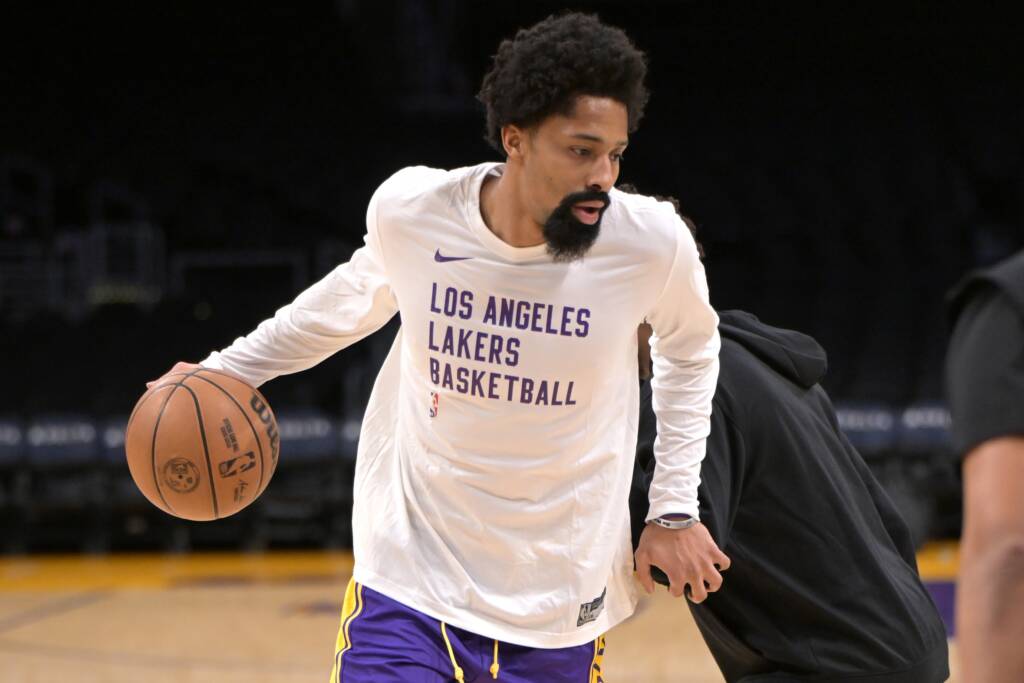When Spencer Dinwiddie signed with the Los Angeles Lakers as a buyout player last season, he made his motives clear. “They know how to win,” Dinwiddie told reporters at his introductory press conference.
The Denver Nuggets eliminated the Los Angeles Lakers in five games, and Dinwiddie enters the offseason as an unrestricted free agent. The Wolves proved they know how to win last season, so they already fit Dinwiddie’s top criteria. Therefore, it’s worth exploring why Dinwiddie would be a fit for the Wolves MLE in his tenth NBA season.
Dinwiddie has valuable experience as a nine-year veteran. He has played for five teams in total and was a member of the Pistons before his breakout season with the Brooklyn Nets. In 2018-19, Dinwiddie and D’Angelo Russell partnered in Brooklyn’s backcourt for its playoff run, where they lost to the Philadelphia 76ers in five games.
The Nets signed Dinwiddie to a three-year, $34.4 million extension after the 2018-19 season. Following an encouraging 2019-20 season, Dinwiddie suffered a right ACL tear that sidelined him for all but three games in 2020-21. After recovering from the Injury, Dinwiddie’s search for an NBA home began. Brooklyn traded him to the Washington Wizards in 2021-22, where he signed a three-year, $54 million extension.
However, Washington flipped Dinwiddie to the Dallas Mavericks midway through the 2021-22 season as part of the Kristaps Porzingis trade. Three hundred sixty-one days later, Dallas made Dinwiddie part of the Kyrie Irving trade that sent him back to Brooklyn at the 2022-23 deadline. At the 2023-24 deadline, the Nets traded Dinwiddie to the Toronto Raptors, who waived him. He signed with the Lakers to end the 2023-24 season.
On his most recent contracts, Dinwiddie, 31, has earned $12 to $18 million annually. However, due to his age and performance, he’s unlikely to garner that much this offseason, making him the perfect candidate for the Wolves to target with their mid-level exception. Dinwiddie is far removed from his 20.6 points per game and 6.8 assists before his knee injury in 2019-20. However, he’s still a capable backup point guard and scorer, and he seems to fit closely with what the Wolves expect offensively.
In 76 games last season, Dinwiddie had a 3.91 assist-to-turnover ratio. Based on his assist ratio, he assisted on 30.3% of his possessions. For context, Mike Conley had a 4.4 assist-to-turnover, and his assist ratio was sitting at 36.2%. These two metrics indicate that Dinwiddie could theoretically fit in behind Conley and provide similar ball movement while limiting turnovers. For the Wolves, limiting turnovers will likely be a focal point after the Wolves ranked sixth in turnovers per game.
Dinwiddie’s shooting also mirrors Conley’s, but he’s not nearly as effective. Dinwiddie shot 39.2% from the field and 33.7% from three, resulting in a 54.3% true shooting percentage. Conley shot 45.7% from the field and 44.2% from deep for a 59.5% true shooting percentage. While the difference appears stark, it’s important to remember that Dinwiddie played on a Brooklyn team that missed the playoffs, then had to assimilate to a Lakers team trying to make a playoff push. Furthermore, teams use the MLE on players who are likely to have holes in their games.
However, Conley and Dinwiddie play similarly offensively. They shot five threes per game and specialized in above-the-break three-point shooting. 74.0 of Dinwiddie’s three-point attempts came from above the break. Unfortunately, he only hit them at a career-low 27.9%. In contrast, Conley had a similar 75.8% of his three-point shots coming from above the break, and he shot 42.7%.
If Dinwiddie signs with the Wolves, they would occasionally expect him to mirror Conley’s play, meaning they’d trust him to stand above the break to create spacing. However, Dinwiddie was a great corner three-point shooter last season, shooting 50.0% from the right corner and 52.6 from the left. Theoretically, that could benefit Minnesota. Nickeil Alexander-Walker and Jordan McLaughlin often shoot from the corners when they play with Anthony Edwards.
Dinwiddie’s potential defensive fit with the Wolves is even more promising. He may not have the reputation of an all-NBA defender. However, Dinwiddie has shown the ability to guard multiple positions, matching up against guards 57.8% of his playing time and forwards 36.6%. His versatility is partly due to his 6’5” frame and his length.
Last season, Dinwiddie demonstrated he is a capable three-point defender, allowing opposing matchups to shoot just 34.5% from deep. For reference, Conley allowed opponents to shoot 32.1% on threes. These stats are encouraging, considering Minnesota’s defensive strategy of rotating and switching guards and crashing out to three-point shooters.
It would be naive to call Dinwiddie the perfect fit for the Wolves. However, he would match the salary slot that the Timberwolves have available, and it could be a good bet that he’d fit in with his play style and Minnesota’s culture, making him a valuable addition.

